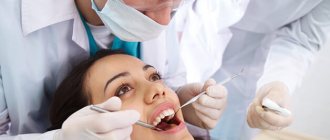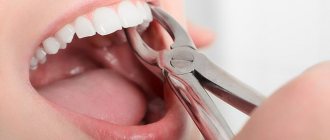What is a wisdom tooth
In everyday life, wisdom teeth are the third molars, or the last, eighth teeth in a row, that is, “eights.”
The upper third molars can vary in shape and size, and are usually smaller than other molars and lower 8s. They have two or three roots, which sometimes grow together into one. But they always have three channels.
The lower wisdom teeth can also vary in shape and size, but, as a rule, they are larger than the upper “eights”. The roots of these teeth are short, sometimes fused, and often have a curved shape.
Features of cutting through “eights”
A characteristic feature of the third molars is the very late time of their eruption - as a rule, this occurs between 16 and 24 years, and sometimes later [1]. That is why in many languages they are called “wisdom teeth”. Late eruption determines the difficulties that many patients face during the development and appearance of “eights.”
The fact is that by this age the upper and lower jaws, as a rule, are already formed. Therefore, the eruption of “eights” is often associated with unpleasant or painful sensations, and often serious complications. Additional difficulties are caused by individual features of the anatomy of the facial skull, for example, the small size of the jaws, in which there is not enough space for the third molars to fully develop. The reason for this, according to most experts, is the evolution of the structure of the human body [2].
Due to the lack of space for full growth, third molars may not fully erupt (retention) or even change the direction of growth (dystopia). Often they begin to grow not vertically up or down, but at an angle to the dentition. Moreover, the size of the slope can be different and largely determines the possible complications of teething. Both retention and dystopia are considered pathological processes [3].
Among the complications of eruption and development of third molars are [3]:
- acute inflammatory process, up to phlegmon (purulent inflammation);
- formation of pathological bone pockets;
- destruction of hard tissues of the adjacent tooth;
- formation of follicular cysts;
- neuralgic pain;
- osteomyelitis and others.
Prevention of teething diseases consists of monitoring the correct development of the jaws and teething, sanitation of the oral cavity and timely orthodontic treatment, compliance with the rules of oral hygiene
“Retention, dystopia. Teething diseases”, Doctor of Medical Sciences, Professor, Head of the Department of Surgical Dentistry of Moscow State Medical University Panin A. M.
Why do wisdom teeth hurt?
The appearance of a figure eight is often accompanied by fever, pain radiating to the ear, neck, enlarged submandibular lymph nodes, swelling and redness of the gums. There are many reasons why a wisdom tooth hurts; painful eruption is often associated with the following situations:
- Formation of the “hood”
- in an adult, the gum tissue is denser than in a child. Because of this, cutting through the figure eight is difficult. When only part of the tooth has erupted, and the other still remains under the gum, a section of tissue covering the erupted crown forms a specific hood. It makes further eruption of the molar difficult. The cause of pain in this situation is the inflammatory process developing under the hood (pericoronitis). - Abnormal growth
– figure eights often grow incorrectly relative to the jaw arch. Since the dentition is formed, there is not enough space for the figure eight. It begins to grow towards the neighboring unit, and the pain covers not only the area of the erupting tooth, but the entire jaw.
If a wisdom tooth that has already erupted begins to hurt, the reasons are most often the following:
- Caries
– the outer molars are located in a hard-to-reach area; it is difficult to clean them well with a brush. Bacterial plaque accumulates more in this area, causing caries. - Pulpitis -
a carious lesion extends beyond the enamel, dentin, and affects the tissue of the pulp chamber (neurovascular bundle). Pulpitis is accompanied by severe, throbbing pain. Endodontic treatment of figure eights does not differ from the techniques applied to other dental units. - Periodontitis is
inflammation of the tissue around the tooth root. It can be acute or chronic. The cause of the development of periodontitis is untreated pulpitis, trauma to the eighth molar, depressurization of a previously filled root canal and penetration of infection into it, and incorrect position of the tooth in the row.
Unpleasant sensations can intensify with the development of diseases of the oral cavity, infection of the dental canals, the formation of cysts, and granulomas. If your wisdom tooth hurts badly, you should immediately consult a dentist.
In what cases is wisdom teeth removal recommended?
The wisdom tooth removal procedure is carried out in several cases:
- as a prevention of complications of eruption and development;
- in the presence of complications;
- with severe tissue damage.
Various complications of eruption (inflammation, difficult eruption, retention, etc.) occur in almost 75% of owners of third molars [3]. These pathologies more often occur with “eights” on the lower jaw. Moreover, in women such complications occur twice as often as in men, which experts explain by the lack of space behind the teeth (retromolar region) in the lower jaw.
The difficult-to-reach location of the third molars means that even regular hygiene procedures do not clean them completely. Therefore, even if they have grown in accordance with the norm, they are often affected by caries. It also affects the lower (69.05%) “eights” more [3].
In the vast majority of cases, regardless of the gender and age of the patient, wisdom teeth are removed for pulp, periodontal and periodontal diseases. Indications for the procedure are [1]:
- the presence of inflammatory processes;
- impossibility of further prosthetics;
- prevention of the healthy state of second molars;
- maintaining gum health.
There are frequent cases of removal of an uncut “eight”. This procedure is performed to prevent complications during teething, as well as the development of crowding of teeth.
When choosing a treatment tactic for a “figure of eight”, specialists evaluate the location of the molar or its rudiment. For an accurate diagnosis, an x-ray examination is performed; it helps to assess the location of the tooth and identify changes in the tissues. In addition, radiation examination helps prevent complications during surgery.
If the eruption of third molars is difficult, the dentist will evaluate the possibility of saving them. As a rule, they try to maintain the “eight” if [3]:
- the tooth is in the correct vertical position;
- its roots are straight;
- periodontal tissues have no changes;
- there is enough space in the dental arch;
- The angle of inclination of the molar does not exceed 150 degrees.
The operation to remove the figure eight is performed under local conduction anesthesia. The specialist may prescribe broad-spectrum antibiotics 40 minutes before the procedure. The oral cavity is treated with antiseptics. The surgeon then performs the removal procedure. After this, the wound is treated and sutured tightly or openly, depending on the dentist’s decision.
Wisdom tooth removal is often associated with various complications. Therefore, there are a number of special techniques that are used by surgeons during the operation. This may be an incision of soft tissue, if necessary, sawing a tooth or other manipulations.
What to do if the problem persists
Outside intervention in the body causes certain reactions, especially if the process was complex. Therefore, complex tooth extraction causes various side effects: swelling of the cheek, bleeding gums, fever. Patients complain of pain in the throat, ear, difficulty chewing and moving the jaws. Anomalies appear from damage to soft tissues. After all, the blood circulating there becomes free. It fills cavities, which leads to swelling. This is what prevents the patient from fully opening his mouth.
After conduction anesthesia, pathologies appear. Therefore, after wisdom tooth removal, it is painful to open your mouth and swallow. If the discomfort gradually subsides, this is normal and there is no need to worry. However, when the pain increases, becomes stronger every day, and does not go away for a long time, the patient must definitely visit a doctor. The sooner this is done, the faster and easier the therapy will be.
Re-cleaning the hole
If it hurts to open your mouth, a specialist should determine the cause of the abnormality. For this purpose, diagnosis is carried out and treatment is prescribed. Often, dentists in such situations clean the wound again. With curved roots, cysts can form and caries can develop, moving into an advanced phase. There are situations when the entire root cannot be removed at once. For the patient to recover, the surgeon must perform another cleaning. Also, this procedure is resorted to when a fragment is accidentally left behind. Pain and discomfort will go away when the wound is clean.
Physiotherapy
When the mouth is difficult to open and the jaw hurts, the following may be prescribed:
- Electrophoresis;
- Ultraviolet irradiation;
- UHF;
- Fluctuarization;
- Laser therapy;
- Magnetotherapy;
- Darsonvalization;
In addition to basic treatment, physiotherapeutic procedures accelerate healing. Complex therapy helps reduce the process of intense inflammation, eliminate discomfort, and fight pathogens.
Antibiotics
A common problem with Eights is dystopia. Since this provokes serious problems, a dystopic wisdom tooth in many cases must be removed. After all, such rudiments are located incorrectly. Their position is not vertical, but horizontal or inclined. Indications for extraction:
- Development of caries, pulpitis, periodontitis, when therapy does not bring a positive result;
- Serious damage to the unit located opposite;
- Impacted organ with inflamed mucous tissue;
- Orthodontic therapy of crowded anterior units;
Drug treatment for complications depends on the characteristics of the patient’s disease. If inflammation develops in the oral cavity, antibiotics are prescribed to eliminate the source of infection. This may be Lincomycin, Ciprolet, Dalacin, Amoxicillin or Ciprofloxacin. Antibacterial agents such as streptocide or sulfacyl can be used.
Jaw development with exercises
For patients with pain, doctors recommend rinsing with chlorhexidine, furatsilin, miramistin 24 hours after surgery. If the mouth does not open completely, the jaws should be developed. If you have difficulty moving, you need to help open the jaw with your fingers. It is important that the patient does not overdo it. Development is performed when the patient experiences mild pain. Gymnastics involves smooth opening of the mouth and soft chewing movements. The load increases gradually.
Full restoration of function will be noticeable after 15-20 days. Massage and heat therapy will help you recover faster. Moving a toothbrush with soft bristles improves blood circulation. Healing is accelerated by mud, paraffin, and ozokerite applications. In the first days, you need to exclude solid foods from your diet. It is useful to eat jelly, grated soups, and liquid porridges. On days 8-12, you can include regular dishes in the menu.
Contraindications for wisdom tooth removal
The surgeon assesses the patient’s condition before surgery based on the medical history and the results of preliminary studies. Removal of wisdom teeth is postponed in the presence of infectious diseases in the acute and subacute periods. These include, among others, influenza, tonsillitis, stomatitis, ARVI and others [1].
If complications of the eruption of “eights”, for example, an inflammatory process, can worsen the patient’s condition, tooth extraction is forced. In such cases, the operation is performed against the background of antibiotic therapy and other anti-inflammatory drugs.
A separate decision is required in cases where wisdom tooth removal is required for cardiovascular diseases, such as a previous myocardial infarction and hypertensive crisis, extrasystole and others. In such situations, the acute condition is usually treated.
The “eight” tooth is removed with special care in case of concomitant blood diseases: hemophilia, thrombopenia, acute leukemia and others. As a rule, the removal procedure is carried out in specialized hospitals.
What to do after wisdom tooth removal
After the removal of third molars, complications are more common than with the removal of other teeth. This is due to the peculiarities of their anatomical structure, retention, complexity and traumaticity of surgical intervention. The most common complications after removal: socket bleeding, “dry socket” and others [9].
After the procedure, it is not recommended to do anything that could remove the blood clot from the wound and impair healing or cause bleeding. The patient is advised to refrain from eating for 2 hours after surgery. At the same time, hot food and drinks are prohibited throughout the day after the procedure, and mouth rinsing is prohibited for the next 24 hours. It is not advisable to smoke, eat sweet, sticky, hard foods or drink with a straw.
List of sources
1. Dentistry. Textbook Aleksandrov M. T., Bazhanov N. N., Medvedev Yu. A., Platonova V. V., Sergeev Yu. N. / Ed. N. N. Bazhanova. - M.: GEOTAR, 2008.
2. Iordanishvili A.K., Ponomarev A.A., Gaivoronskaya M.G., Korovin N.V. Age-related features of wisdom teeth diseases // Kursk scientific and practical bulletin “Man and his health”. 2015. No. 4. URL: https://cyberleninka.ru/article/n/vozrastnye-osobennosti-zabolevaniy-zubov-mudrosti (date of access: 06/13/2020).
3. Marugina T. L., Kan V. V., Fedotov V. V., Zagorodnikh E. S. Diagnosis, prevention and treatment of diseases of the eruption of the lower eighth teeth // Russian Journal of Education and Psychology. 2012. No. 4. URL: https://cyberleninka.ru/article/n/diagnostika-profilaktika-i-lechenie-bolezney-prorezyvaniya-nizhnih-vosmyh-zubov (date of access: 06.13.2020).
4. Iordanishvili A.K., Ponomarev A.A., Korovin N.V., Lyskov N.V. Complications after removal of wisdom teeth and their treatment // Kursk scientific and practical bulletin “Man and his health”. 2022. No. 2. URL: https://cyberleninka.ru/article/n/oslozhneniya-posle-udaleniya-zubov-mudrosti-i-ih-lechenie (date of access: 06/13/2020).
Content:
- What to do before deleting the eight
- What happens in the oral cavity during the extraction of the eighth tooth?
- What to do after wisdom tooth removal 3.1. The first day after removal 3.2. Second day after pulling out figure eight 3.3. Third and fourth days after wisdom tooth removal 3.4. A week after wisdom tooth removal 3.5. A month later
After a wisdom tooth is removed, the socket often becomes infected. Because of this, severe swelling forms and the tissues become inflamed. To exclude the development of negative complications, you need to properly prepare for surgery and follow all medical recommendations after it.










